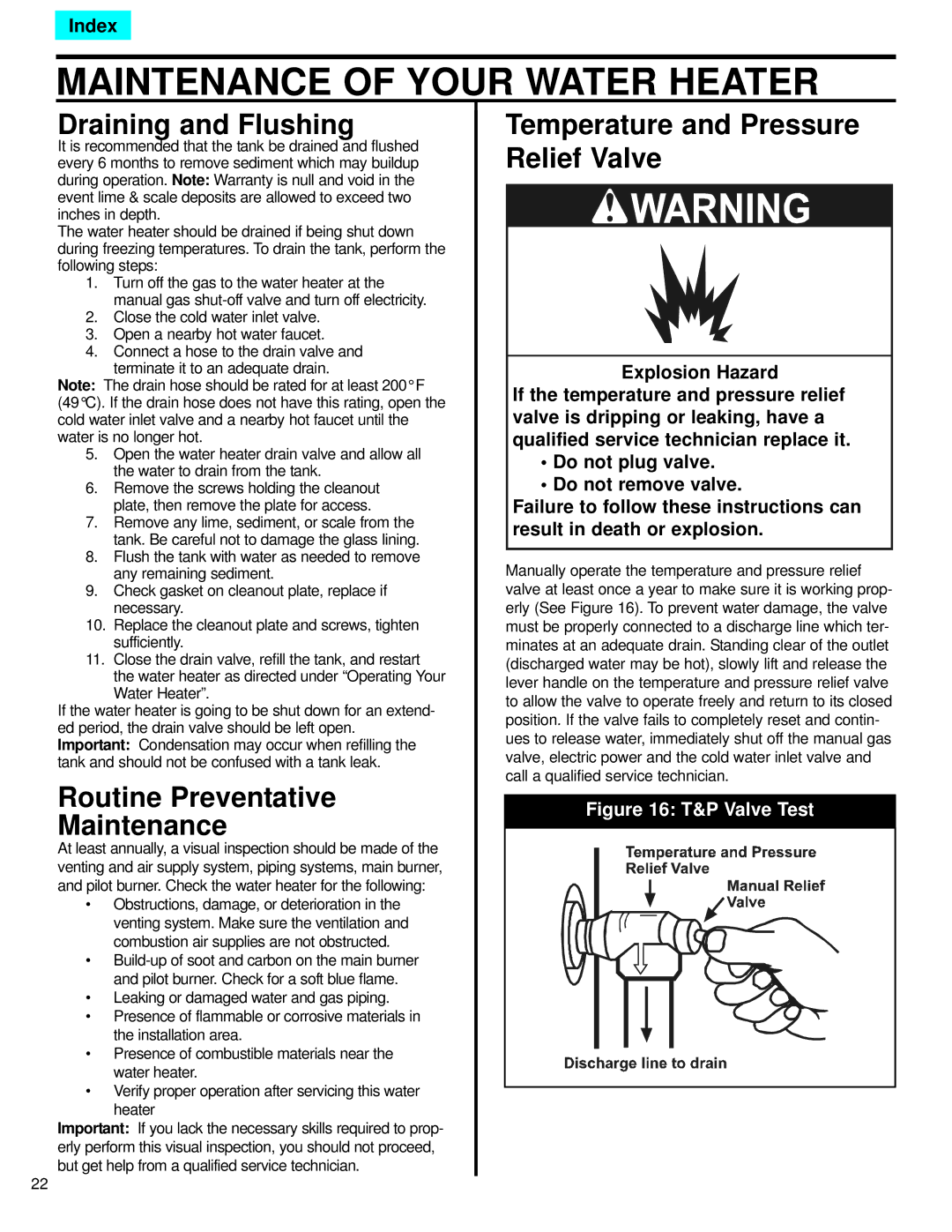
Index
MAINTENANCE OF YOUR WATER HEATER
Draining and Flushing
It is recommended that the tank be drained and flushed every 6 months to remove sediment which may buildup during operation. Note: Warranty is null and void in the event lime & scale deposits are allowed to exceed two inches in depth.
The water heater should be drained if being shut down during freezing temperatures. To drain the tank, perform the following steps:
1.Turn off the gas to the water heater at the manual gas
2.Close the cold water inlet valve.
3.Open a nearby hot water faucet.
4.Connect a hose to the drain valve and
terminate it to an adequate drain.
Note: The drain hose should be rated for at least 200°F (49°C). If the drain hose does not have this rating, open the cold water inlet valve and a nearby hot faucet until the water is no longer hot.
5.Open the water heater drain valve and allow all the water to drain from the tank.
6.Remove the screws holding the cleanout plate, then remove the plate for access.
7.Remove any lime, sediment, or scale from the tank. Be careful not to damage the glass lining.
8.Flush the tank with water as needed to remove any remaining sediment.
9.Check gasket on cleanout plate, replace if necessary.
10.Replace the cleanout plate and screws, tighten sufficiently.
11.Close the drain valve, refill the tank, and restart
the water heater as directed under “Operating Your Water Heater”.
If the water heater is going to be shut down for an extend- ed period, the drain valve should be left open. Important: Condensation may occur when refilling the tank and should not be confused with a tank leak.
Routine Preventative
Maintenance
At least annually, a visual inspection should be made of the venting and air supply system, piping systems, main burner, and pilot burner. Check the water heater for the following:
•Obstructions, damage, or deterioration in the venting system. Make sure the ventilation and combustion air supplies are not obstructed.
•
•Leaking or damaged water and gas piping.
•Presence of flammable or corrosive materials in the installation area.
•Presence of combustible materials near the water heater.
•Verify proper operation after servicing this water
heater
Important: If you lack the necessary skills required to prop- erly perform this visual inspection, you should not proceed, but get help from a qualified service technician.
22
Temperature and Pressure Relief Valve
Explosion Hazard
If the temperature and pressure relief valve is dripping or leaking, have a qualified service technician replace it.
•Do not plug valve.
•Do not remove valve.
Failure to follow these instructions can result in death or explosion.
Manually operate the temperature and pressure relief valve at least once a year to make sure it is working prop- erly (See Figure 16). To prevent water damage, the valve must be properly connected to a discharge line which ter- minates at an adequate drain. Standing clear of the outlet (discharged water may be hot), slowly lift and release the lever handle on the temperature and pressure relief valve to allow the valve to operate freely and return to its closed position. If the valve fails to completely reset and contin- ues to release water, immediately shut off the manual gas valve, electric power and the cold water inlet valve and call a qualified service technician.
